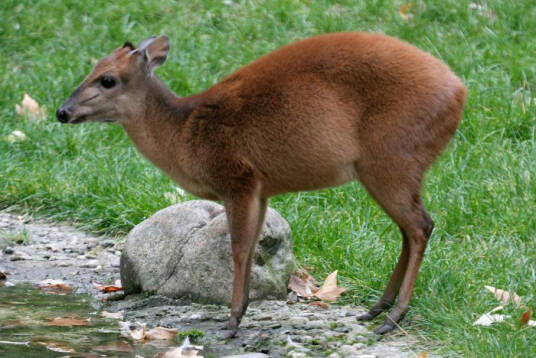Cephalophus natalensis
IUCN
LCBasic Information
Scientific classification
- name:Cephalophus natalensis
- Scientific Name:
- Outline:Ungulata
- Family:Artiodactylus Bovidae Gazella
Vital signs
- length:70-80cm
- Weight:9.2-13.6kg
- lifetime:About 15 years
Feature
Both sexes have yellow-brown fur, with individuals in the northern part of the range having a brighter, more reddish-brown fur.
Distribution and Habitat
Distributed in Estonia, Malawi, Mozambique, South Africa, Tanzania and Zambia.
Once widespread from southeastern Tanzania to northeastern KwaZulu-Natal in South Africa in coastal and riverine forests and scrub, escarpment and montane forests (1999, 2013). There are no confirmed records of the species in Zimbabwe or Zambia, where it was reported in northeastern Zambia and northern Malawi in 1999.
Inhabits coastal and riparian forests in southeastern Africa. Altitudes range from sea level to 200 m above sea level. The species' optimal habitat is canopy-forming trees with a mixture of open understory (for foraging) and dense scrub (for shelter).
Appearance
The red duiker is 70-80 cm long, 38-48 cm tall at the shoulder, and 8-11 cm long tail; adults weigh 9.2-13.6 kg. It is relatively small and slender relative to its species, with females often larger and heavier than males. The fur of both sexes is yellow-brown. Individuals in the northern part of the distribution range have a brighter, more reddish-brown fur. The underparts are usually slightly paler than the rest of the body. The back of the neck is gray-brown, with no dorsal stripe. The tail is narrow and thin, with a white tip. The face is slightly darker than the body, with a white chin and black edges on the small ears. The long dreadlocks on the forehead are usually chestnut brown. Both sexes have thick, spiked horns, which are shorter in females, 2-4.5 cm long, and may be hidden within the frontal crest. The male's horns are usually 4.5-8.0 cm long, up to 10.1 cm long, with a heavy ring at the base.
Details
The Red Duiker (Cephalophus natalensis) is the only red duiker in its range; it is larger and has a more reddish-brown coat than the blue duiker and the natalensis. The Habsburg duiker is sometimes considered a subspecies of the Red Duiker, but can be distinguished by its darker legs and black facial flames.

The red duiker is almost entirely a diurnal species, with significant activity peaks after dawn and before dusk. However, most of the day (24-69%) may be spent resting under dense green shade cover. Usually acts alone. They do not appear to be territorial, and the home ranges of multiple individuals may overlap. There are few lasting social connections. In overlapping territories, these duikers tend not to use the same territory at the same time. Home range size usually ranges from 2-15 hectares. Red duikers usually feed in open areas of the forest understory, but if frightened they will almost immediately rush out for cover. Although "duiker" means "diver" (they usually dive headfirst into dense vegetation), this species is an excellent jumper and can clear obstacles up to 1.6 meters. On many occasions, red duikers have been observed socializing with green monkeys, not only feeding on food dropped by the monkeys but also allowing the primates to groom them.
Red duikers feed mainly on fallen leaves, fruits, seeds and flowers. Natural enemies include many medium and large predators including leopards.
The red duiker is a non-seasonal breeding animal and can give birth year-round. The gestation period is 216 days. 1 litter per litter. Young antelope weigh about one kilogram at birth and are very dark in color - almost black. For at least the first two weeks, newborns are hidden in dense bushes and are regularly nurtured and nursed by their mothers. Life span is up to 15 years.
Densities recorded by Bowland in 1990 ranged from 1/0.5-1.0 ha in favorable habitats (e.g. St. Lucia) to 1/2.5-5.0 ha in unfavorable areas. East (1999) gave a total population estimate of approximately 42,000 individuals, although the actual number is likely much larger. Although a large portion of this range occurs in Mozambique, where overall recovery of wildlife populations is likely to include the red duiker (East 1999, Hoffmann and Bowland 2013), population trends are gradually declining throughout much of the species' range.
Listed in the "World Conservation Union Red List of Threatened Species" (IUCN) 2016 ver3.1 - Least Concern (LC).
Protect wild animals and eliminate wild game.
Maintaining ecological balance is everyone’s responsibility!








